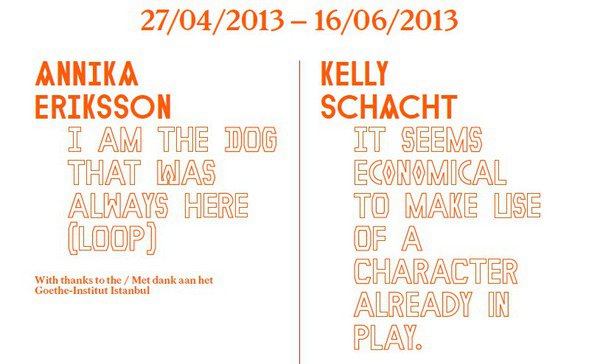25/4/2013
Annika Eriksson - Kelly Schacht
Kiosk, Ghent
Eriksson bases her work in scenarios where the perception of time, structures of power, and once acclaimed social visions are called into question. 'It seems economical to make use of a character already in play' by Schacht, the empty rooms will be activated by temporary interventions or 'characters' whose performative presence will resound in the human absence emphasized by Eriksson.

KIOSK presents an exhibition that combines work by Swedish artist Annika Eriksson and Belgian artist Kelly Schacht.
With 'I am the dog that was always here (loop)', KIOSK presents the first exhibition in Belgium by Annika Eriksson. Eriksson bases her work in scenarios where the perception of time, structures of -power, and once acclaimed social visions are called into question. Strategically, she plays with debates around the public realm and structures that regulate it, revealing urban changes and how this is subject to unexpected political appropriations and inversions.
Eriksson's works in the exhibition engages with questions of time, its documented forms, and its reversal. Throughout the rooms, Eriksson sets up a number of possible scenarios in video works and three-dimensional interventions that include photographs, light boxes and panes of glass – extended elements of the film in space. The central piece of the presentation is the new video installation in the hemicycle room called 'I am the dog that was always here (loop)' (2013). The video, set in the outskirts of Istanbul, focuses on moments of transition and marginalised experiences of time, seen through the lens of a street dog. Having been moved by the authorities to peripheral pockets and no man's lands outside the expanding city, the dogs are continuously moving along lines of gentrification and corporate city making. Through looping and repetition, Eriksson relates this process to an experience of time: exploring the present as a complex gap between past and future, one in which an increasing process of erasure, spurred on by a shrinking public realm, also removes other registers of being and seeing.
Kelly Schacht in turn responds to the exhibition space and Annika Eriksson's work. For the duration of her show 'It seems economical to make use of a character already in play' the empty rooms will be activated by temporary interventions or 'characters' whose performative presence will resound in the human absence emphasized by Eriksson. This approach is based in the uncertain and in coincidence: an openness that is prerequisite for Schacht's ongoing research into the perception and practice of exhibiting and the dynamic space in which it takes place. By way of theatrical constructions, Schacht stages a fragmented dialogue between space and matter, illusion and reality.
In 'It seems economical to make use of a character already in play' this approach results in a scenario, tailored to the exhibition space, that will unfold over the course of the seven weeks of the exhibition. Like a postscript, this minimal scenography will address what is hidden and appeal to the visitors' imagination.
Both artists – each grounded in their respective generations – work with the same kind of ideas in presentations that rely on the staged and the imaginary, and on the factors of time, language, the viewer and social interaction. With their cinematographic constructions and minimal interventions they introduce the audience into a fragmented narrative dimension. Where Eriksson mainly directs the exhibition space through the use of film, Schacht manipulates it with the aid of objects and people. Both narrative styles make use of the reversal of time and language, giving their scenarios an aura both of recognition and of the indefinable, like blind spots or ambiguous vacuums in space and time.
Annika Eriksson's 'I am the dog that was always here (loop)' was realized with the support of the Goethe-Institut, Istanbul.
Annika Eriksson has previously presented solo shows in, or was commissioned by:
'When Attitudes Became Form Become Attitudes', Wattis Institute, San Francisco (2012); Kunstlerhaus Stuttgart (2012); 'Europe N', GFZK, Leipzig (2011); DAAD Galerie, Berlin (2010); Hayward Gallery, London (2010) and Sheffield Biennale (2008). Eriksson took part in numerous international group shows including Shanghai Biennale and Kiev Biennale (2012), Venice Biennale (2005) and Sao Paulo Biennale (2002). Eriksson is represented by KROME Gallery, Berlin and NON Gallery, Istanbul.
Kelly Schacht received the 2011 'Young Belgian Painters Award' and has showed her work at the Gwangju Biennial (2012); De Vleeshal, Middelburg (2011); Hoet Bekaert Gallery, Ghent; Cultuurcentrum Strombeek, Grimbergen; 'Coupe de ville', Sint-Niklaas (2010); Netwerk – Centre for Contemporary Art (2008); and in 'Coming People' in S.M.A.K, Ghent (2006), among others. She is represented by Meessen De Clercq, Brussels.
Opening 26 april
KIOSK
Louis Pasteurlaan 2 - 9000 Ghent, Belgium
Opening hours during exhibitions:
Tuesday – Friday: 14:00 – 18:00
Saturday – Sunday: 11:00 – 18:00
Monday: closed
From 24.12.12 until 6.12.13 only open from Thursday through Sunday



